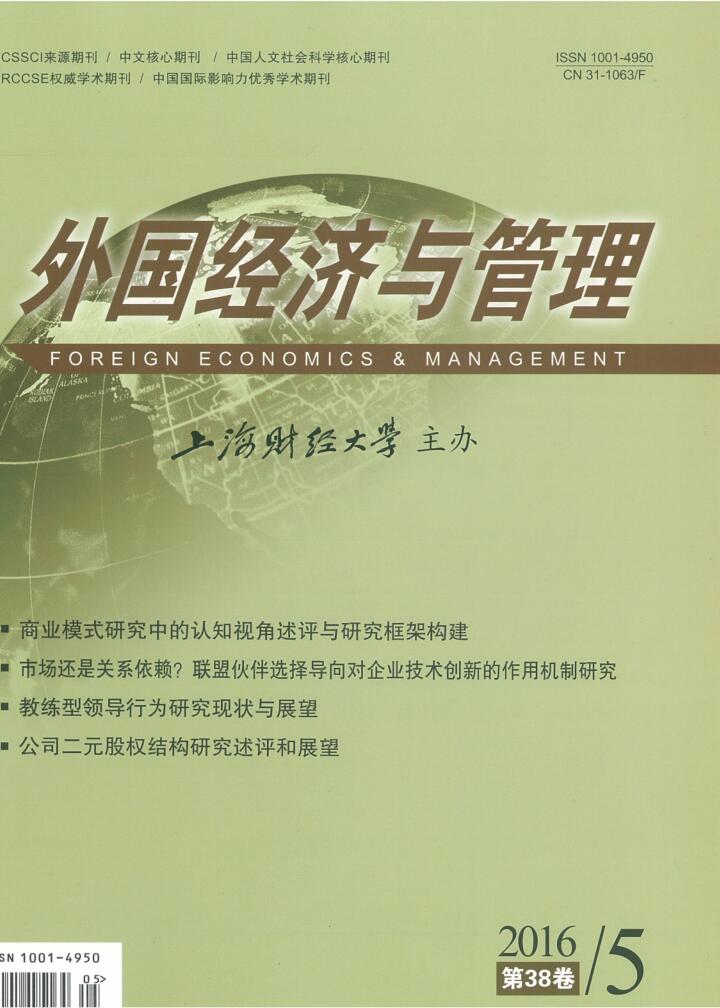合作伙伴选择对企业联盟战略目标的实现具有重要的理论与实践意义。市场导向和关系导向联盟伙伴选择对焦点企业的技术创新水平提升会产生不一样的影响。本文以联盟伙伴选择与技术创新的目标结果关系出发,引入知识整合作为中介变量,以123家高科技企业为研究对象,提出并验证了市场导向和关系导向联盟伙伴选择对企业技术创新有显著影响,但不同的联盟伙伴选择战略对不同类型技术创新的影响程度不同。市场导向伙伴选择主要促进突破式创新,关系导向伙伴选择主要促进渐进式创新。双元知识整合在联盟伙伴选择与技术创新的关系之间产生中介作用。互补型知识整合是市场导向联盟伙伴选择与突破式创新的中介变量,辅助型知识整合是关系导向联盟伙伴选择与渐进式创新的中介变量。
市场还是关系依赖?联盟伙伴选择导向对企业技术创新的作用机制研究
摘要
参考文献
1 奉小斌,陈丽琼. 外部知识搜索能提升中小微企业协同创新能力吗?——互补性与辅助性知识整合的中介作用[J]. 科学学与科学技术管理,2015,(8):105-117.
2 焦豪. 双元型组织竞争优势的构建路径:基于动态能力理论的实证研究[J]. 管理世界,2011,(11):76-91.
3 魏江,徐蕾. 知识网络双重嵌入、知识整合与集群企业创新能力[J]. 管理科学学报,2014,(2):34-47.
4 Anand B N,Khanna T. Do firms learn to create value? The case of alliances[J]. Strategic Management Journal,2000,21(3):295-315.
5 Baum J A C,Rowley T J,Shipilov A V,et al. Dancing with strangers:Aspiration performance and the search for underwriting syndicate partners[J]. Administrative Science Quarterly,2005,50(4):536-575.
6 Burt R S. Structural holes:The social structure of competition[M]. Cambridge:Harvard University Press,2009.
7 Faems D,Janssens M,Neyens I. Alliance portfolios and innovation performance:Connecting structural and managerial perspectives[J]. Group & Organization Management,2012,37(2):241-268.
8 Gerlach M L. Alliance capitalism:The social organization of Japanese business[M]. Berkeley,CA:University of California Press,1992.
9 Gibson C B,Birkinshaw J. The antecedents,consequences,and mediating role of organizational ambidexterity[J]. Academy of Management Journal,2004,47(2):209-226.
10 Golonka M. Proactive cooperation with strangers:Enhancing complexity of the ICT firms' alliance portfolio and their innovativeness[J]. European Management Journal,2015,33(3):168-178.
11 Govindarajan V,Kopalle P K. Disruptiveness of innovations:Measurement and an assessment of reliability and validity[J]. Strategic Management Journal,2006,27(2):189-199.
12 Grant R M. Prospering in dynamically-competitive environments:Organizational capability as knowledge integration[J]. Organization Science,1996,7(4):375-387.
13 Gulati R,Sytch M. Dependence asymmetry and joint dependence in interorganizational relationships:Effects of embeddedness on a manufacturer's performance in procurement relationships[J]. Administrative Science Quarterly,2007,52(1):32-69.
14 Hitt M A,Ahlstrom D,Dacin M T,et al. The institutional effects on strategic alliance partner selection in transition economies:China vs. Russia[J]. Organization Science,2004,15(2):173-185.
15 Hoang H,Rothaermel F T. The effect of general and partner-specific alliance experience on joint R&D project performance[J]. Academy of Management Journal,2005,48(2):332-345.
16 Hoffmann W H. Strategies for managing a portfolio of alliances[J]. Strategic Management Journal,2007,28(8):827-856.
17 Lavie D. Alliance portfolios and firm performance:A study of value creation and appropriation in the U. S. software industry[J]. Strategic Management Journal,2007,28(12):1187-1212.
18 Li J J,Poppo L,Zhou K Z. Do managerial ties in China always produce value? Competition,uncertainty,and domestic vs. foreign firms[J]. Strategic Management Journal,2008,29(4):383-400.
19 Li J,Young M N,Tang G Y. The development of entrepreneurship in Chinese communities:An organizational symbiosis perspective[J]. Asia Pacific Journal of Management,2012,29(2):367-385.
20 Li S X,Rowley T J. Inertia and evaluation mechanisms in interorganizational partner selection:Syndicate formation among U. S. investment banks[J]. Academy of Management Journal,2002,45(6):1104-1119.
21 Li S X,Rowley T J. Inertia and evaluation mechanisms in interorganizational partner selection:Syndicate formation among U. S. investment banks[J]. Academy of Management Journal,2002,45(6):1104-1119.
22 Li Y,Peng M W. Developing theory from strategic management research in China[J]. Asia Pacific Journal of Management,2008,25(3):563-572.
23 McCutcheon D,Stuart F I. Issues in the choice of supplier alliance partners[J]. Journal of Operations Management,2000,18(3):279-301.
24 Meuleman M,Lockett A,Manigart S,et al. Partner selection decisions in interfirm collaborations:The paradox of relational embeddedness[J]. Journal of Management Studies,2010,47(6):995-1019.
25 Mitsuhashi H. Uncertainty in selecting alliance partners:The three reduction mechanisms and alliance formation processes[J]. The International Journal of Organizational Analysis,2002,10(2):109-133.
26 Park S H,Ungson G R. The effect of national culture,organizational complementarity,and economic motivation on joint venture dissolution[J]. Academy of Management Journal,1997,40(2):279-307.
27 Rothaermel F T,Boeker W. Old technology meets new technology:Complementarities,similarities,and alliance formation[J]. Strategic Management Journal,2008,29(1):47-77.
28 Schildt H A,Maula M V J,Keil T. Explorative and exploitative learning from external corporate ventures[J]. Entrepreneurship Theory and Practice,2005,29(4):493-515.
29 Sidhu J S,Commandeur H R,Volberda H W. The multifaceted nature of exploration and exploitation:Value of supply,demand,and spatial search for innovation[J]. Organization Science,2007,18(1):20-38.
30 Sirmon D G,Hitt M A,Ireland R D,et al. Resource orchestration to create competitive advantage:Breadth,depth,and life cycle effects[J]. Journal of Management,2011,37(5):1390-1412.
31 Subramaniam M,Youndt M A. The influence of intellectual capital on the types of innovative capabilities[J]. Academy of Management Journal,2005,48(3):450-463.
32 Moeller K. Partner selection,partner behavior,and business network performance:An empirical study on German business networks[J]. Journal of Accounting & Organizational Change,2010,6(1):27-51.
33 Walter A,Auer M,Ritter T. The impact of network capabilities and entrepreneurial orientation on university spin-off performance[J]. Journal of Business Venturing,2006,21(4):541-567.
34 Wassmer U,Dussauge P. Network resource stocks and flows:How do alliance portfolios affect the value of new alliance formations?[J]. Strategic Management Journal,2012,33(7):871-883.
35 Wuyts S,Geyskens I. The formation of buyer-supplier relationships:detailed contract drafting and close partner selection[J]. Journal of Marketing,2005,69(4):103-117.
36 Xie E,Peng M W,Zhao W H. Uncertainties,resources,and supplier selection in an emerging economy[J]. Asia Pacific Journal of Management,2013,30(4):1219-1242.
37 Yi Y Q,Liu Y,He H,et al. Environment,governance,controls,and radical innovation during institutional transitions[J]. Asia Pacific Journal of Management,2012,29(3):689-708.
引用本文
邓渝. 市场还是关系依赖?联盟伙伴选择导向对企业技术创新的作用机制研究[J]. 外国经济与管理, 2016, 38(5): 18–31.
导出参考文献,格式为:
下一篇:分布式创新理论研究述评





 6590
6590  6761
6761

